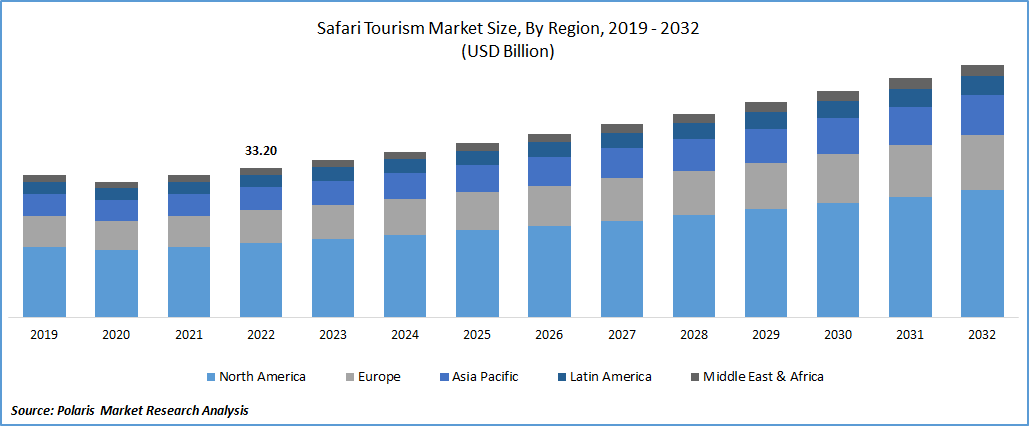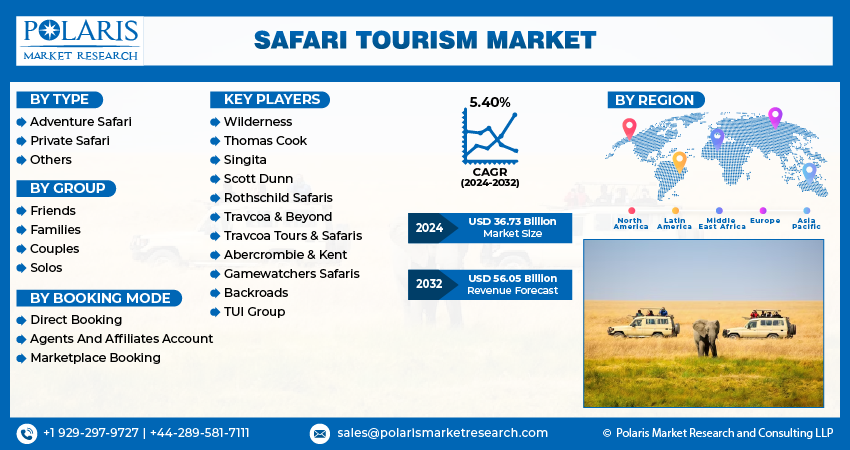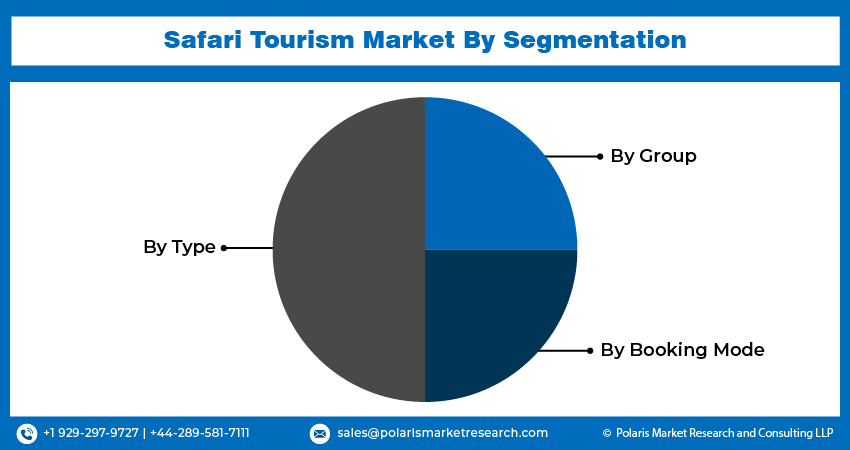
Safari Tourism Market Share, Size, Trends, Industry Analysis Report, By Type (Adventure Safari, Private Safari), By Group (Friends, Families, Couples, Solos), By Booking Mode, By Region, And Segment Forecasts, 2024 - 2032
- Published Date:Jan-2024
- Pages: 114
- Format: PDF
- Report ID: PM3581
- Base Year: 2023
- Historical Data: 2019-2022
Report Outlook
The global safari tourism market was valued at USD 34.91 billion in 2023 and is expected to grow at a CAGR of 5.40% during the forecast period. The growing interest of travel bloggers and influencers in this type of travel drives the growth of safari tourism. Bloggers and influencers with a substantial following on social media platforms are showcasing their safari experiences and generating interest among their audience. This, in turn, is fueling the demand for safari travel. The rise in popularity of safari tourism can be attributed to several factors. Firstly, there is an increasing preference among people for unique and exotic holiday experiences. Safari travel offers the opportunity to witness wildlife in their natural habitats, which highly appeals to travelers seeking extraordinary adventures. Additionally, the growth of the middle and upper-middle-class population has resulted in increased expenditure on travel and leisure activities. This demographic segment often seeks exclusive and memorable experiences, making safari tourism an attractive option.

To Understand More About this Research: Request a Free Sample Report
As per the statistics published by the United Nations World Tourism Organization (UNWTO) titled 'Towards Measuring the Economic Value of Wildlife Watching Tourism in Africa' reveals that wildlife tourism accounts for 7% of global tourism and exhibits an annual growth rate of around 3%. The report emphasizes that entrance fees for protected sites and areas in 14 African countries collectively generate approximately USD 142 million. This figure is projected to increase, driven by the growing demand from travelers, particularly millennials, who are keen on engaging in tourism activities that offer the opportunity to experience pristine natural environments and observe wildlife in their natural habitats.
There is an increasing emphasis on sustainability and responsible tourism within the safari industry. Travelers are now prioritizing minimizing their environmental impact, supporting local communities, and contributing to wildlife conservation efforts. They actively seek out eco-friendly accommodations, participate in conservation initiatives, and prefer to engage with operators that prioritize sustainability.
Industry Dynamics
Growth Drivers
Governments and tourism organizations worldwide actively promote wildlife and safari tourism to stimulate safari tourism market growth. The government has taken notable initiatives in India to enhance and strengthen the safari tourism sector. These efforts include wildlife conservation, visitor experiences, infrastructure development, and community engagement. Indian government's commitment to promoting safari tourism is implementing the Integrated Development of Wildlife Habitats (IDWH) scheme by the Ministry of Environment, Forests, and Climate Change (MoEFCC). The IDWH scheme aims to support the conservation and management of wildlife and their habitats. It focuses on enhancing infrastructure, implementing effective protection measures, and fostering capacity building to facilitate sustainable wildlife tourism.

Report Segmentation
The market is primarily segmented based on type, group, booking mode, and region.
|
By Type |
By Group |
By Booking Mode |
By Region |
|
|
|
|
To Understand the Scope of this Report: Speak to Analyst
Couples segment accounted for the largest market share in 2022
The couples segment accounted for the largest market share in 2022. Segment's prominence can be attributed to its allure for couples seeking extraordinary and unforgettable experiences. Exploring breathtaking landscapes, encountering wildlife together, and relishing intimate moments in nature are key attractions for couples who value unique and romantic adventures. According to the CBI, in 2021, 42% of millennials in Europe preferred traveling with their partners. The allure of safari tourism lies in its ability to offer a blend of romance, adventure, and awe-inspiring encounters with wildlife, making it an ideal choice for couples seeking to embark on a memorable and enriching journey together.
The friend segment is expected to register a robust growth rate. The growing interest in group travel, especially among millennials, is expected to be a significant catalyst for the friend segment's growth in safari tourism. The allure of embarking on adventurous journeys with friends, exploring captivating landscapes, and encountering wildlife together creates an enticing proposition. The shared experiences, camaraderie, and memories formed during these group trips contribute to the overall appeal of safari tourism for friends' travel.
Direct booking segment garnered largest share in 2022
The direct booking segment held the largest revenue share. Segment's prominence can be attributed to the remarkable technological advancements in recent years, such as card scanners, mobile payments, voice recognition search, and artificial intelligence (AI), along with the widespread availability of online booking platforms. According to the Adventure Travel Trade Association's (ATTA) 2022 Adventure Travel Industry Snapshot, 62% of global bookings are made directly with the service providers. This statistic highlights the increasing trend among travelers to take charge of their safari experiences by directly interacting with the businesses offering these services.
Marketplace mode is expected to register the fastest growth rate. Marketplace booking platforms have gained popularity due to their ability to provide a wide range of safari options from multiple travel operators in one centralized location. Travelers can easily search for safaris, compare offerings, and make informed decisions based on their preferences and requirements. One significant advantage of marketplace booking platforms is the availability of customer support services. These services ensure a seamless and hassle-free booking process for travelers. Support is provided throughout the journey, including assistance with booking, making itinerary changes, and addressing any concerns or issues that may arise before, during, or after the safari experience.

Private safari grown at the fastest rate in 2022
Private safari witnessed a steady growth rate in 2022. The rise of the private safari segment is driven by the growing preference among travelers for customization and personalization. Travelers seek to have their safari experiences tailored to their interests, preferences, and schedules. This includes personalized itineraries, activities, and accommodations catering to their needs. Exclusivity and privacy are key factors driving the popularity of private safaris. Travelers value the opportunity to explore wildlife-rich destinations without large crowds, allowing for a more intimate and secluded experience. This exclusivity often extends to luxury and high-end accommodations, providing travelers exceptional comfort and amenities during their safari.
Middle East region dominated the global market in 2022
Middle East region dominated the global market with considerable market share. The Middle East and Africa region has experienced economic growth, leading to increased disposable income and the ability to indulge in luxury travel experiences such as safaris. The rising middle-class population in the region has contributed to the surge in demand for safari tourism as families seek memorable and adventurous vacations. Furthermore, Africa has emerged as a highly desirable destination for international travelers. The continent boasts many attractions, including picturesque beaches, diverse national parks teeming with wildlife, and exceptional ecotourism offerings. These natural wonders, combined with Africa's rich cultural heritage and delectable cuisine, have captivated the attention of travelers worldwide.
APAC registered a robust growth rate. Governments and tourism organizations recognize the value of adventure and nature-based tourism experiences, such as safaris, in attracting travelers. This focus on promoting active tourism aligns with the preferences of modern travelers who seek immersive and experiential journeys, including wildlife encounters and natural exploration. The World Travel & Tourism Council has reported significant GDP growth of 7.5% in the travel and tourism sector in the region from 2021 to 2022. This underscores the economic significance of the tourism industry in the region and further highlights the potential for growth in the safari tourism segment.

Competitive Insight
Some of the major players operating in the global market include Wilderness, Thomas Cook, Singita, Scott Dunn, Rothschild Safaris, Travcoa & Beyond, Travcoa Tours & Safaris, Abercrombie & Kent, Gamewatchers Safaris, Backroads, and TUI Group.
Recent Developments
- In May 2023, &Beyond revealed its plans to renovate the Phinda Forest Lodge within the &Beyond Phinda Private Game Reserve in KwaZulu Natal, South Africa. To minimize any negative impact on the delicate environment, the refurbishment project will focus on utilizing the existing lodge and room structures rather than starting from scratch. This approach aims to preserve the lodge's original "Zulu-zen" concept while incorporating modern architectural elements.
- In April 2023, Wilderness introduced the Wilderness Mokete tented camp in the Mababe Concession of Botswana. Situated across 124,000 acres between the Okavango Delta & Chobe National Park, this secluded haven provides ample opportunities for observing a diverse range of wildlife. It is noteworthy as the inaugural camp of its kind in this area.
Safari Tourism Market Report Scope
|
Report Attributes |
Details |
|
Market size value in 2024 |
USD 36.73 billion |
|
Revenue forecast in 2032 |
USD 56.05 billion |
|
CAGR |
5.40% from 2024 – 2032 |
|
Base year |
2023 |
|
Historical data |
2019 – 2022 |
|
Forecast period |
2024 – 2032 |
|
Quantitative units |
Revenue in USD billion and CAGR from 2024 to 2032 |
|
Segments covered |
By Type, By Group, By Booking Mode, By Region |
|
Regional scope |
North America, Europe, Asia Pacific, Latin America; Middle East & Africa |
|
Key companies |
Wilderness, Thomas Cook, Singita, Scott Dunn, Rothschild Safaris, Travcoa & Beyond, Travcoa Tours & Safaris, Abercrombie & Kent, Gamewatchers Safaris, Backroads, and TUI Group. |
FAQ's
The safari tourism market report covering key segments are type, group, booking mode, and region.
Safari Tourism Market Size Worth $56.05 Billion By 2032.
The global safari tourism market is expected to grow at a CAGR of 5.4% during the forecast period.
Middle East is leading the global market.
key driving factors in safari tourism market are governments and tourism organizations are actively promoting safari tourism.
